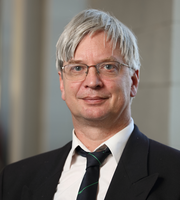First results from the Muon g-2 experiment unveiled
The first result from the Muon g-2 experiment at Fermilab was unveiled and discussed publicly on Wednesday, 7 April 2021, in a special set of online seminars, that attracted widespread attention.
The Muon g-2 experiment is studying the so-called muon magnetic anomaly, the fact that the magnetic dipole moment of the muon differs from the simplest Dirac prediction given by setting the relevant parameter g=2. The discrepancy is due to subtle couplings to virtually excited particles "sparking" fleetingly from the vacuum. This coupling to virtual excitations of the vacuum opens a rare opportunity for indirect exploration of particles and fields that may exist outside the Standard Model (SM), now 50 years old, and so far maddeningly impervious to experimental challenges.
The newly revealed Fermilab result essentially confirms the previous, 20 year old value from Brookhaven National Lab, which was already at significant variance from the SM calculations. The new world average is even farther in statistical significance (4.2 sigma) from the SM value. The current Fermilab result reflects only 6% of the planned full data set, and, with measurements are continuing, Muon g-2 is on course to achieve a four-fold improvement in precision in a few years' time. At the same time significant progress is being made on the theoretical front, to make full use of the improved experimental precision.
UVa professors Dinko Počanić and Stefan Baeßler are among the founding members of the Fermilab Muon g-2 experiment, and remain active collaborators, along with their research groups.
Prof. Počanić was interviewed by UVAToday for a feature article:
Links to further reading:
- https://www.nytimes.com/2021/04/07/science/particle-physics-muon-fermilab-brookhaven.html
- https://news.fnal.gov/2021/04/first-results-from-fermilabs-muon-g-2-experiment-strengthen-evidence-of-new-physics/
- https://www.quantamagazine.org/muon-g-2-experiment-at-fermilab-finds-hint-of-new-particles-20210407/
Here are the links to the main papers presenting the new result:
- "Measurement of the positive muon anomalous magnetic moment to 0.46 ppm" by the Muon g-2 Collaboration: B. Abi et al., Phys. Rev. Lett. 126 (2021) 141801, https://journals.aps.org/prl/abstract/10.1103/PhysRevLett.126.141801
- "Magnetic-field measurement and analysis for the Muon g−2 Experiment at Fermilab" by the Muon g-2 Collaboration: B. Albahri et al., Phys. Rev. A 103 (2021) 042208, https://journals.aps.org/pra/abstract/10.1103/PhysRevA.103.042208
- "Measurement of the anomalous precession frequency of the muon in the Fermilab Muon g-2 experiment" by the Muon g-2 Collaboration: B. Albahri et al., Phys. Rev. D 103 (2021) 072002, https://journals.aps.org/prd/abstract/10.1103/PhysRevD.103.072002
- "Beam dynamics corrections to the Run-1 measurement of the muon anomalous magnetic moment at Fermilab" by the Muon g-2 Collaboration: B. Albahri et al., https://arxiv.org/abs/2104.03240
 Physics at Virginia
Physics at Virginia

